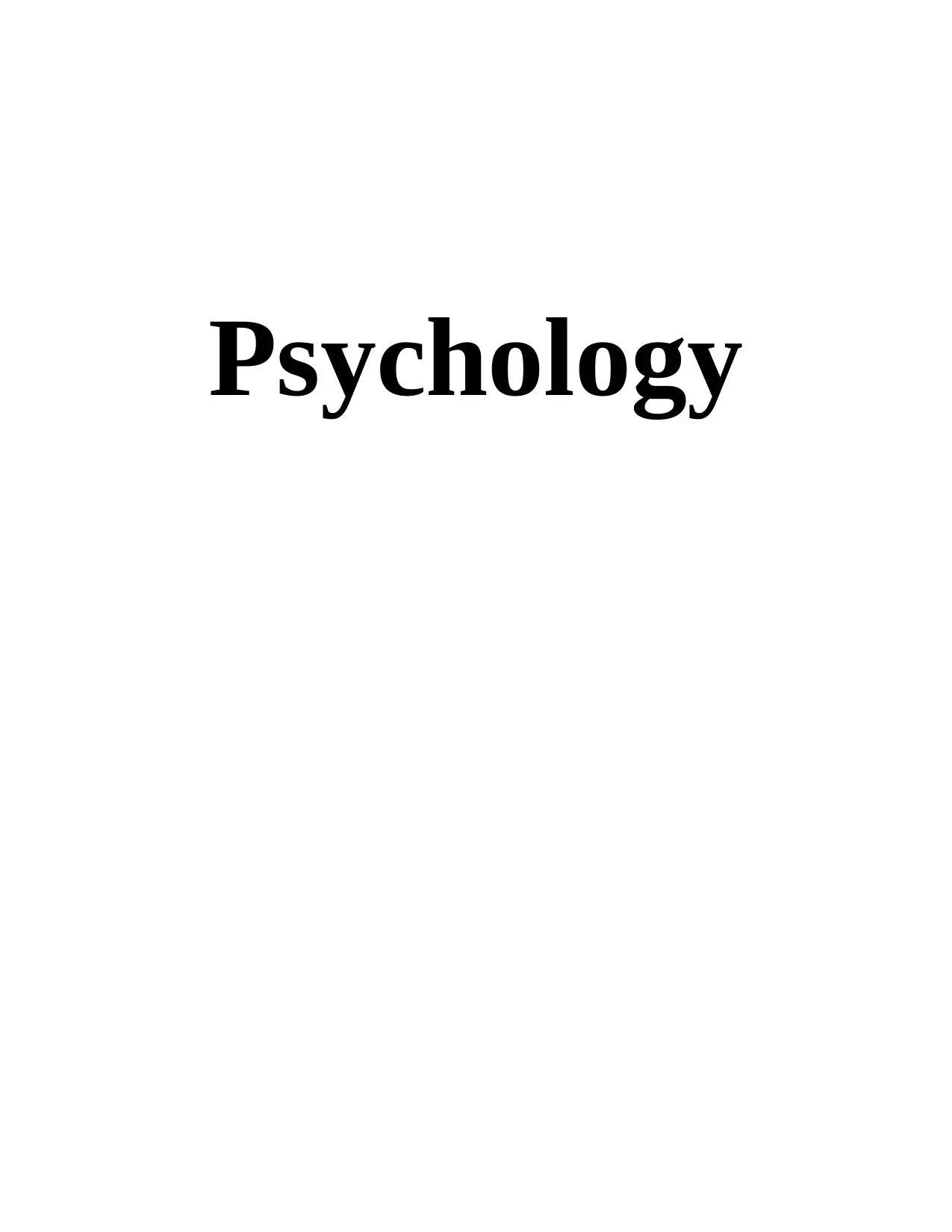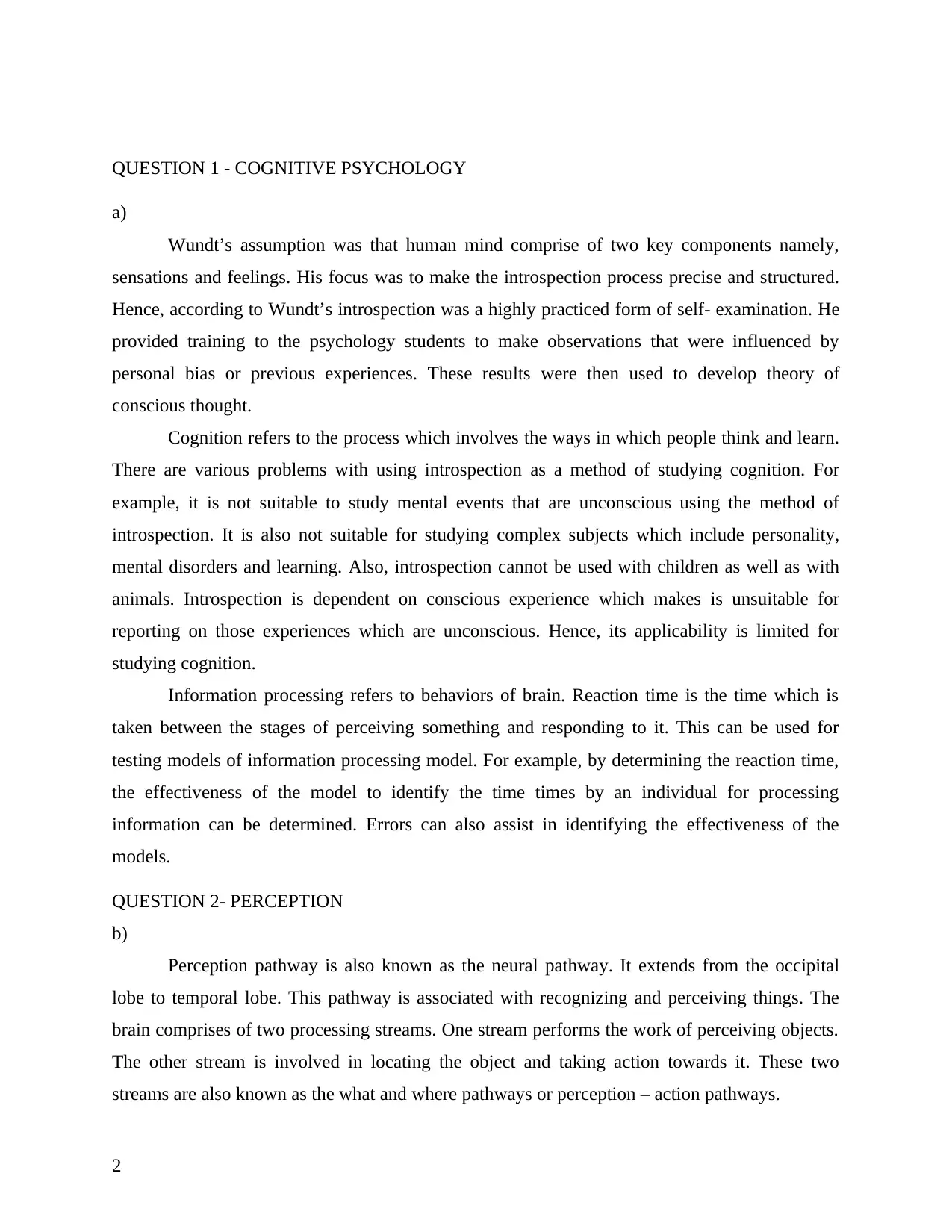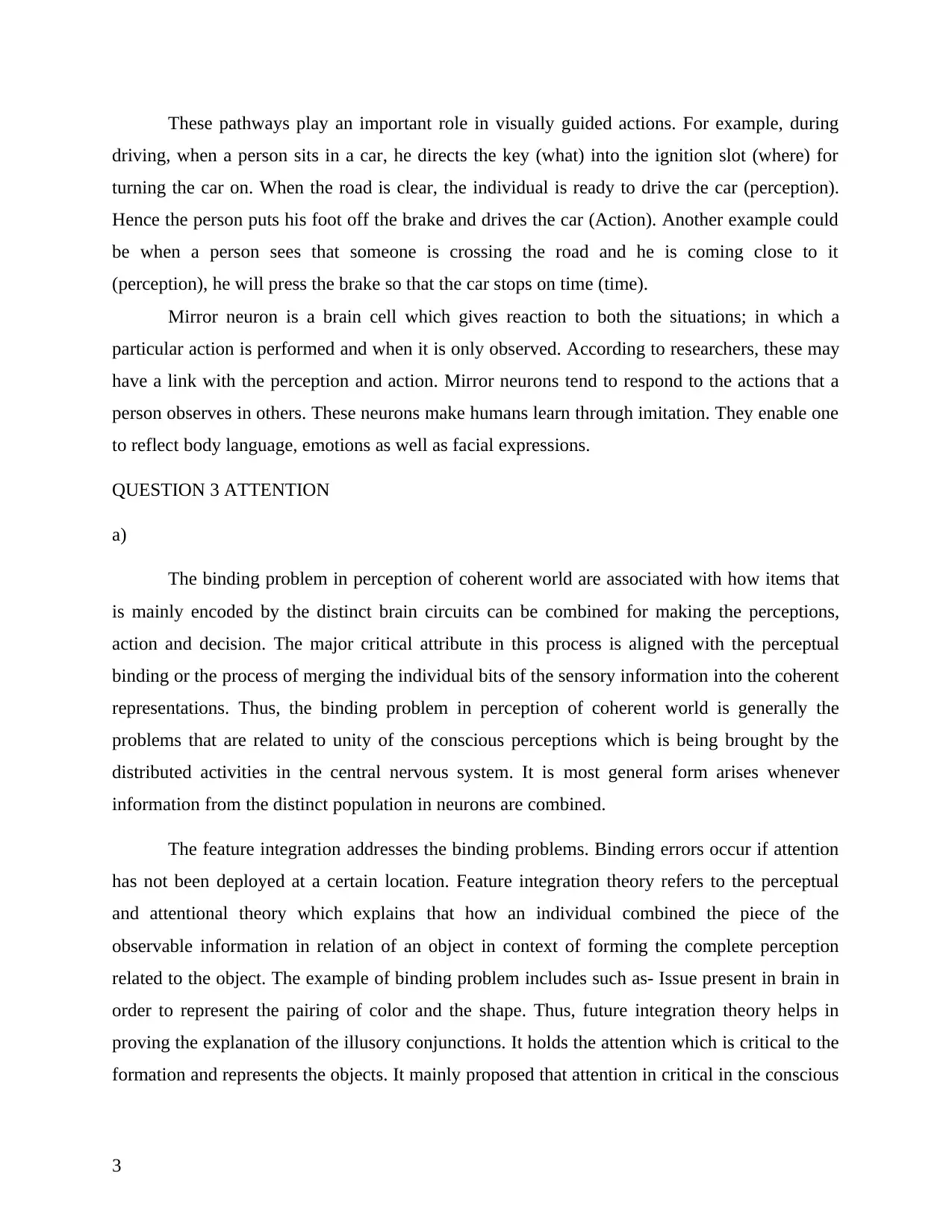Psychology: Cognitive Processes, Perception, and Memory Analysis
VerifiedAdded on 2023/06/09
|4
|1120
|223
Homework Assignment
AI Summary
This assignment solution addresses key concepts in cognitive psychology, perception, and memory. It begins by examining Wundt's method of analytic introspection and its limitations, followed by a discussion on how reaction times and errors are used to test information processing models. The solution then explores perception pathways, including the "what" and "where" pathways, and the role of mirror neurons. The binding problem and feature integration theory are also analyzed. Finally, the assignment differentiates between implicit and explicit memory, detailing their various forms and providing examples. The solution also covers procedural, semantic, and episodic memory, along with different types of priming.

Psychology
Paraphrase This Document
Need a fresh take? Get an instant paraphrase of this document with our AI Paraphraser

QUESTION 1 - COGNITIVE PSYCHOLOGY
a)
Wundt’s assumption was that human mind comprise of two key components namely,
sensations and feelings. His focus was to make the introspection process precise and structured.
Hence, according to Wundt’s introspection was a highly practiced form of self- examination. He
provided training to the psychology students to make observations that were influenced by
personal bias or previous experiences. These results were then used to develop theory of
conscious thought.
Cognition refers to the process which involves the ways in which people think and learn.
There are various problems with using introspection as a method of studying cognition. For
example, it is not suitable to study mental events that are unconscious using the method of
introspection. It is also not suitable for studying complex subjects which include personality,
mental disorders and learning. Also, introspection cannot be used with children as well as with
animals. Introspection is dependent on conscious experience which makes is unsuitable for
reporting on those experiences which are unconscious. Hence, its applicability is limited for
studying cognition.
Information processing refers to behaviors of brain. Reaction time is the time which is
taken between the stages of perceiving something and responding to it. This can be used for
testing models of information processing model. For example, by determining the reaction time,
the effectiveness of the model to identify the time times by an individual for processing
information can be determined. Errors can also assist in identifying the effectiveness of the
models.
QUESTION 2- PERCEPTION
b)
Perception pathway is also known as the neural pathway. It extends from the occipital
lobe to temporal lobe. This pathway is associated with recognizing and perceiving things. The
brain comprises of two processing streams. One stream performs the work of perceiving objects.
The other stream is involved in locating the object and taking action towards it. These two
streams are also known as the what and where pathways or perception – action pathways.
2
a)
Wundt’s assumption was that human mind comprise of two key components namely,
sensations and feelings. His focus was to make the introspection process precise and structured.
Hence, according to Wundt’s introspection was a highly practiced form of self- examination. He
provided training to the psychology students to make observations that were influenced by
personal bias or previous experiences. These results were then used to develop theory of
conscious thought.
Cognition refers to the process which involves the ways in which people think and learn.
There are various problems with using introspection as a method of studying cognition. For
example, it is not suitable to study mental events that are unconscious using the method of
introspection. It is also not suitable for studying complex subjects which include personality,
mental disorders and learning. Also, introspection cannot be used with children as well as with
animals. Introspection is dependent on conscious experience which makes is unsuitable for
reporting on those experiences which are unconscious. Hence, its applicability is limited for
studying cognition.
Information processing refers to behaviors of brain. Reaction time is the time which is
taken between the stages of perceiving something and responding to it. This can be used for
testing models of information processing model. For example, by determining the reaction time,
the effectiveness of the model to identify the time times by an individual for processing
information can be determined. Errors can also assist in identifying the effectiveness of the
models.
QUESTION 2- PERCEPTION
b)
Perception pathway is also known as the neural pathway. It extends from the occipital
lobe to temporal lobe. This pathway is associated with recognizing and perceiving things. The
brain comprises of two processing streams. One stream performs the work of perceiving objects.
The other stream is involved in locating the object and taking action towards it. These two
streams are also known as the what and where pathways or perception – action pathways.
2

These pathways play an important role in visually guided actions. For example, during
driving, when a person sits in a car, he directs the key (what) into the ignition slot (where) for
turning the car on. When the road is clear, the individual is ready to drive the car (perception).
Hence the person puts his foot off the brake and drives the car (Action). Another example could
be when a person sees that someone is crossing the road and he is coming close to it
(perception), he will press the brake so that the car stops on time (time).
Mirror neuron is a brain cell which gives reaction to both the situations; in which a
particular action is performed and when it is only observed. According to researchers, these may
have a link with the perception and action. Mirror neurons tend to respond to the actions that a
person observes in others. These neurons make humans learn through imitation. They enable one
to reflect body language, emotions as well as facial expressions.
QUESTION 3 ATTENTION
a)
The binding problem in perception of coherent world are associated with how items that
is mainly encoded by the distinct brain circuits can be combined for making the perceptions,
action and decision. The major critical attribute in this process is aligned with the perceptual
binding or the process of merging the individual bits of the sensory information into the coherent
representations. Thus, the binding problem in perception of coherent world is generally the
problems that are related to unity of the conscious perceptions which is being brought by the
distributed activities in the central nervous system. It is most general form arises whenever
information from the distinct population in neurons are combined.
The feature integration addresses the binding problems. Binding errors occur if attention
has not been deployed at a certain location. Feature integration theory refers to the perceptual
and attentional theory which explains that how an individual combined the piece of the
observable information in relation of an object in context of forming the complete perception
related to the object. The example of binding problem includes such as- Issue present in brain in
order to represent the pairing of color and the shape. Thus, future integration theory helps in
proving the explanation of the illusory conjunctions. It holds the attention which is critical to the
formation and represents the objects. It mainly proposed that attention in critical in the conscious
3
driving, when a person sits in a car, he directs the key (what) into the ignition slot (where) for
turning the car on. When the road is clear, the individual is ready to drive the car (perception).
Hence the person puts his foot off the brake and drives the car (Action). Another example could
be when a person sees that someone is crossing the road and he is coming close to it
(perception), he will press the brake so that the car stops on time (time).
Mirror neuron is a brain cell which gives reaction to both the situations; in which a
particular action is performed and when it is only observed. According to researchers, these may
have a link with the perception and action. Mirror neurons tend to respond to the actions that a
person observes in others. These neurons make humans learn through imitation. They enable one
to reflect body language, emotions as well as facial expressions.
QUESTION 3 ATTENTION
a)
The binding problem in perception of coherent world are associated with how items that
is mainly encoded by the distinct brain circuits can be combined for making the perceptions,
action and decision. The major critical attribute in this process is aligned with the perceptual
binding or the process of merging the individual bits of the sensory information into the coherent
representations. Thus, the binding problem in perception of coherent world is generally the
problems that are related to unity of the conscious perceptions which is being brought by the
distributed activities in the central nervous system. It is most general form arises whenever
information from the distinct population in neurons are combined.
The feature integration addresses the binding problems. Binding errors occur if attention
has not been deployed at a certain location. Feature integration theory refers to the perceptual
and attentional theory which explains that how an individual combined the piece of the
observable information in relation of an object in context of forming the complete perception
related to the object. The example of binding problem includes such as- Issue present in brain in
order to represent the pairing of color and the shape. Thus, future integration theory helps in
proving the explanation of the illusory conjunctions. It holds the attention which is critical to the
formation and represents the objects. It mainly proposed that attention in critical in the conscious
3
⊘ This is a preview!⊘
Do you want full access?
Subscribe today to unlock all pages.

Trusted by 1+ million students worldwide

experience in bound representation. Thus, feature integration theory helps in solving binding
problems within detecting attention level.
QUESTION 4 MEMORY
b)
Implicit memory has been considered as unconscious memory or the automatic memory
which is aligned with the perceptional and the emotional unconscious memories that influences
the behavior of an individual. Whereas, explicit memory has been considered as the declarative
memory that involves the personal experience of person that can consciously retrieve and
articulate. Forms of implicit memory involves- Procedural learning, priming, category learning
and perceptual learning. Form of explicit memory involves- Semantic memory, episodic memory
and Episodic memory.
Semantic memory has been determined as the part of long-term memory that is mainly
responsible for storing information in relation of world. This involves the knowledge related to
the meaning of words. Autobiographical memory is associated with the various events that is
based on the past and personal experience. Episodic memory is accountable for storing
information related to those events that has been experienced in lives. Procedural memory is
being defined as that memory system charged the encoding storage and then retrieve the
procedure rather than remembering the complete event. For example- Riding a bike.
The different forms of priming and conditioning involves positive & negative priming,
semantic priming, repetition, semantic, masked, response and associative priming. Positive and
negative priming shows how priming impacts processing speed. Semantic involves the logical
ways and associate involves two variables that are associated with each other. The prospective
memory mainly requires the retrospective memory as one must need to remember information in
order to react in future. It is different form as it refers to self-ability of person.
4
problems within detecting attention level.
QUESTION 4 MEMORY
b)
Implicit memory has been considered as unconscious memory or the automatic memory
which is aligned with the perceptional and the emotional unconscious memories that influences
the behavior of an individual. Whereas, explicit memory has been considered as the declarative
memory that involves the personal experience of person that can consciously retrieve and
articulate. Forms of implicit memory involves- Procedural learning, priming, category learning
and perceptual learning. Form of explicit memory involves- Semantic memory, episodic memory
and Episodic memory.
Semantic memory has been determined as the part of long-term memory that is mainly
responsible for storing information in relation of world. This involves the knowledge related to
the meaning of words. Autobiographical memory is associated with the various events that is
based on the past and personal experience. Episodic memory is accountable for storing
information related to those events that has been experienced in lives. Procedural memory is
being defined as that memory system charged the encoding storage and then retrieve the
procedure rather than remembering the complete event. For example- Riding a bike.
The different forms of priming and conditioning involves positive & negative priming,
semantic priming, repetition, semantic, masked, response and associative priming. Positive and
negative priming shows how priming impacts processing speed. Semantic involves the logical
ways and associate involves two variables that are associated with each other. The prospective
memory mainly requires the retrospective memory as one must need to remember information in
order to react in future. It is different form as it refers to self-ability of person.
4
1 out of 4
Your All-in-One AI-Powered Toolkit for Academic Success.
+13062052269
info@desklib.com
Available 24*7 on WhatsApp / Email
![[object Object]](/_next/static/media/star-bottom.7253800d.svg)
Unlock your academic potential
Copyright © 2020–2025 A2Z Services. All Rights Reserved. Developed and managed by ZUCOL.

